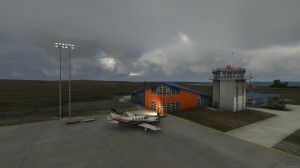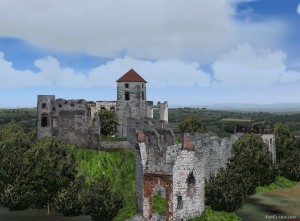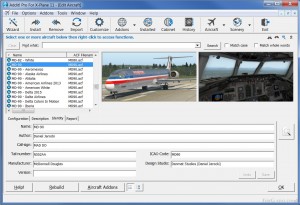Scenery
The Ghost Airport Collection Pennsylvania. The Ghost Airport Collection is a collection of forty-six Pennsylvania airports for FSX that used to exist but now are gone or virtually gone. These airports are now malls or shopping centers, industrial complexes, housing developments, parks, schools universities, farm land, etc, etc. In some cases the airport is still recognizable but unused or partially used for another purpose. All the airports in this collection fit that criteria. Many airports that comprise this collection came from a March 1940 Cleveland sectional chart I inherited from my father. There are airports that existed in 1940 and still exist as an airport in one form or another today. Those airports still in existence are not a ghost airport. Signs of their existence are still th
Show more... ere today like at the former location of Bettis airport near Pittsburgh (now the Southland Shopping Center) that has a nearby street named, Luscombe Lane. I bet that many residents of that street who lack an aviation background do not realize the significance of that name. In one case an airport became a housing development and the runway became the main road in the development. To preserve the heritage of the land, they named the main road, Runway Avenue. Oil Citys Splane Memorial Airport still exists in whole but is used as the citys composting facility. These airports have been built in FSX using aerial photographs from Penn Pilot (www. pennpilot. psu. edu) and with great deal of aid from Google Earth. A web site called Abandoned & Little-Known Airfields was also exceptionally helpful. You will need to use a little imagination when visiting these airports because I used only stock buildings that come with Airport Design Editor library. These airports were built using Airport Design Editor v1. 40. 07. In the era of the airports represented here, the average runway was a two thousand foot grass strip. Even the paved fields average length was around two thousand feet. Some of these airports were built by the government for use by the air mail pilots. In most cases they obtained the use of some farm field pasture land and kept it somewhat mowed (not over knee-high). They used the flying field concept where pilots landed whatever way they had enough length and was mostly into the wind. Designate an official runway?-Naw! The runways were often laid out over mildly rolling hills. Rolling hills is a function where Flight Simulator has a bit of a handicap. You can leave the natural (digitized) lay of the land in place but it tends to be pointy and uneven making for some bumpy landings. Where the polygons intersect, the transition is not always smooth and a wheel or the landing gear may disappear into the ground. As a result, in most cases, I have opted to flatten the terrain. This results in both positive and negative embankments at the edge of the airport. While these cases do not represent 100% the actual airport appearance, they work better than the un-flattened version. In the updated versions included in Update 5, several of the airports are now un-flattened. I have developed a method that allows the airports to follow the surrounding terrain. I used this method at airport that generated large embankments. There were airports where they must have built up cut down the exiting terrain because using the natural terrain would result in exceedingly steep slopes on the runways. At a couple of airports, when the aircraft reach certain spots on the runway, they would be totally below the runway surface. I had to leave airports like that flattened. There is at least one airport that is missing one of the runway starts. This was caused from the runway start being set (automatically) at airport elevation, ten feet below the surrounding terrain. FSX tries to resolve the difference between the start point and the terrain and creates an area of tall grass where the landing gear disappears and the aircraft seems to sink in to the grass up to the bottom of the doors. I have tried to find the original identifiers for these airports. I have only found Oil Citys identifier (KOIL) and Scranton Municipals (KSCR) so far. I contacted the office of Penndot that licenses airports but they said they archive records that old in a warehouse making them virtually unavailable. They are not even sure they used identifiers for all airports of that era. Flight Simulator requires an identifier for each airport so I just made up identifiers for most of these airports. Those identifiers I made up are, in reality, identifiers for heliports that are not used in FSX. If anybody has information on what the real identifiers for any of the ghost airports were, please let me know. Installation. This is very simple. Just unzip the downloaded file and put all resulting. BGL files in ~~microsoft flight simulator X Addons sceneryscenery. Let the new files overwrite the old files. For your convenience, Update 5 includes the latest versions of all airports (except Waynesboro) in the Ghost Airports Pennsylvania Collection. If you have missed any previous updates, this will bring your Ghost Airports Pennsylvania collection up to date whether there was an actual update to a particular airport for Update 5 or not. IMPORTANT. You must go into the folder where the addon scenery files are located (usually that is ~~microsoft flight simulator X Addons sceneryscenery) and remove the two files that begin with KSCN so that they do not compete with the new version of that airport that has the corrected identifier KSCR. Here is a list of the airports in this collection. Airport Identifier Name City 5D7 Aliquippa Hopewell Aliquippa KALT Altoona Duncansville KBDV Mayer Bridgeville KBTT Bettis Pittsburgh KDUB DuBois DuBois KGRV Grove City Grove City KHEM Harri-Errery Bradford KMCR Mercer Mercer KOIL Splane Memorial Oil City KPNX Punx-Brae Marchand KRSG Kearsarge Erie KSCR Scranton Municipal Scranton (Schultzville) KTSV Col. Drake Titusville KWAR Warren Warren KWYB Waynesboro Waynesboro P99N Peterson Memorial Tipton PA10 State College Boalsburg PA11 Taylorville Ashland PA12 Benninger Tionesta PA13 Erie County Fairview PA26 Keystone Emporium PA28 Leechburg Leechburg PA29 Blain Blain PA34 Seneca Airpark Seneca PA37 Patterson Heights Beaver Falls PA38 (Old) Bellefonte Bellefonte PA41 Emlenton Emlenton PA93 Conneaut Lake Conneaut Lake PA94 Kylertown Ames Kylertown PA99 Franklin Franklin PN26 New Holland New Holland PN28 Pittsburgh Greensburg Greensburg PN41 ClearfieId ClearfieId PN42 Brookville Brookville PN44 Roulette Roulette PN45 Penn Mead Meadville PN51 Conway Conway PN58 Buckstown Buckstown PN60 Johnston (East Pittsburgh) Monroeville PN63 Pierce Auxiliary Sharpsville PN70 Hamilton Indiana PN75 State College Air Depot State College PN77 Matamoras Matamoras PN78 Vandergrift Vandergrift PN80 Pitt-Wilkins Monroeville PN88 Rhea Clarion PN94 Kane Auxiliary Kane Aliquippa Hopewell (5D7). This airport, located about five northwest of Greater Pittsburgh, on a hill top catty-corner across the valley intersection from the hillside where USAir flight 427 crashed. Originally, Aliquippa Hopewell had two grass runways. Later they went to a single paved fifteen hundred foot north south runway that lined up with the access notch they had in the Greater Pittsburgh control zone. The airport boasted a factory where they produced the Volaire 100, This design was eventually sold to Rockwell and produced as the Aero Commander 100 The AC100 evolved into the Darter Commander and later the more powerful Lark Commander. The updated airport has a more detailed road structure surrounding the airport and more detail on the airport itself. Refueling spot enabled near southwest hangar. Altoona (KALT). Located outside of Altoona near a little village called Duncansville, this typical little airport boasted some fancy artwork on the surface of the field that included the airport name. Update 5 improves airport scenery, adds US Route 220 (now known as old 220 and Inlow Rd. ) along with several other minor roads. Added refueling spot near two Cubs. I added a railroad that was there in 1939 but is abandoned today. This railroad is interesting in that, as it comes out of the hills west of Duncansville, the original right of way appears to have paralleled the Foot of Ten road straight into Duncansville. For some reason (probably to reduce steepness of that segment of the railroad) they went to the trouble and expense of detouring the track to the south by about eight tenths of a mile toward the eventual location of the Blue Knob Valley airport forming a parallelogram that came back alongside the Altoona Airport then curved to the east and rejoined the straight-through right of way. Mayer (KBDV). Located at Bridgeville, PA, this was Pittsburghs first airport. It was built and owned by a local brickmaker named Casper Mayer who had a great interest in aviation. It was your basic flying field configuration designed to accommodate the biplanes of the day. It eventually had two designated runways the longest of which measured sixteen hundred feet. Update 5 enables Refueling spot at Mayer Bettis (KBTT). This was Pittsburghs second airport. It served during the 1920s and 1930s. Its two thousand foot runways restricted its practical use to that period. Choosing a runway configuration to model was not simple. The airport evolved over the years and when they did pave runways, they did not pave the entire extent of the grass runways. I chose the apparent longest grass configuration. Bettis was replaced by the largest airport in the nation (at that time), Allegheny County Airport which was built only a mile away. Bettis continued to serve aviation as the home of Pittsburgh Institute of Aeronautics for years after the airport itself closed. An interesting aside to this story is that in the 1938 aerial photo of Bettis I could not help but notice Allegheny County Airport shows four intersecting runways. The eight runway ends were not identified according to magnetic heading. They were simply numbered 1 through 8. I do not know if they actually used that numbering system or if this photo was doctored for some other purpose. All I know is that is the way it shows up on the Penn Pilot database. Update 5 enables fuel spot at Bettis. Dubois (KDUB). This airport was close to the town of Dubois and was eventually replaced by the Dubois Jefferson airport (DUJ) that was built in a less congested area. The update improves road structure. If you search for Schwans Foods in Dubois, PA on Google Earth, you can just barely make out the airport outline. Update 5 upgrades scenery and road structure around the airport. Refueling spot is also enabled. Grove City (KGRV). This privately owned paved airport served Grove City for years. In the 1970s it appeared on the charts as a restricted airport. It eventually closed and Grove City built the new Grove City airport (29D). Update 5 improves road structure, surrounding scenery, airport buildings and adds grass taxiway to 12 and enables refueling spot. Harri-Emery (KHEM). This early airport served Bradford, PA from the 1920s to the 1970s. This airport was the home of the Taylor brothers airplane manufacturing facility where the early Taylor Cubs were produced. In 1931 the Taylor brothers were forced into bankruptcy due to a slump in sales and the Piper Cub was born. This airport continued to serve Bradford until it closed in 1971. Some fliers continued to use the field after it was officially closed. By 1977 it was part of the University of Pittsburgh at Bradford campus. The original hangar still exists and houses the student union. Update 5 improves scenery on the airport at Harri-Emery and adds two hangars, the Taylor Aircraft factory and a refueling spot. Mercer (KMCR). This was one of the federally funded airports established to support the U. S. Air mail system. It had an airway beacon light on the field and a low-frequency range station nearby. When government support dried up, local support just was not there and this airport faded into history. In the ensuing years someone built a narrow private strip across the road from the site of the Mercer airport. The cut through the woods for that airport can still be seen on Google Earth. I never knew that airport to be licensed. FSX scenery designers seem to think western Pennsylvania is primarily forested interrupted by a few towns and cities. This means that most of the airports I built were alone in the middle of an seemingly unending forest with no coherent road structure nearby. This upgrade improves surrounding road structure and local scenery. Splane Memorial (KOIL
Show less...







